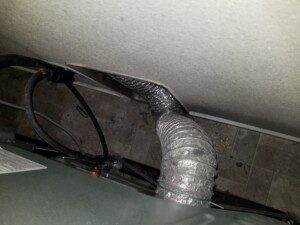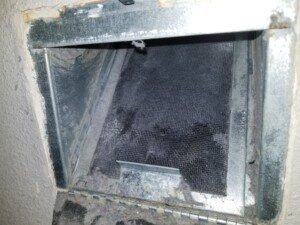
Dryer vents work by directing the hot and humid air from the interior of the dryer to the exterior of the home, preventing that humid air from creating moisture and mold problems inside. Not only can an improperly operating dryer vent cause moisture related problems, but can also be a fire hazard if it becomes clogged with lint. Approximately 2,900 dryer fires are report in the U.S. each year, costing over 35 million dollars in property loss, with the leading cause being failure to clean the dryer.

Dryer lint screen in wall.
Maintaining your dryer vent starts with the lint trap, which is often in a sliding compartment in the front of the dryer and can also occasionally be found at a secondary trap found in the wall behind the dryer. Lint traps keep lint from moving into the dryer vent and should be cleaned before every dryer cycle to keep your dryer functioning properly and to keep lint from accumulating in the vent or duct termination at the exterior. Cleaning the interior of the whole dryer vent duct is also recommended annually.
Dryer duct hoses can also become damaged, torn, crushed, or clogged and may eventually require replacement. To replace your dryer vent hose, first pull your dryer away from the wall to give you some room to work and unplug the dryer. Use a screwdriver or pliers to remove the dryer vent hose from the dryer and the wall vent connection. Using dryer vents composed of flexible foil laminate or flexible vinyl is not recommended as the extra ridges in these vents can trap lint, decrease dryer efficiency, and increase the chances for a dryer fire. A better option is using a semi-rigid aluminum or rigid metal vent to connect to the rigid wall vent connection (flexible dryer vents are only acceptable in the first 8 feet from the dryer and all dryer vents hidden within construction should be rigid metal). Be sure to seal you dryer duct tightly so that humid air cannot escape into the living space and is vented directly out to the exterior.
